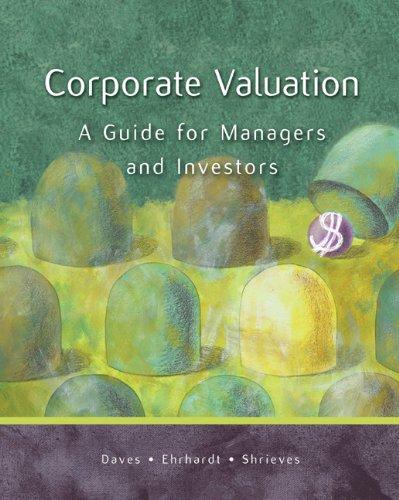Question
Each group picks a company. The company should be publicly traded and have at least one year of trading history and one set of annual
Each group picks a company. The company should be publicly traded and have at least one year of trading history and one set of annual financial statements. The company can be listed in any market.
There should be a common theme in each group. The theme can be broadly defined. For instance, an entertainment group can include movie companies, television broadcasters and syndication companies. An automobile group can include auto companies, suppliers to auto companies and even an auto dealership. In putting together the group of companies, try to pick as diverse a mix of companies as possible (small and large, domestic and foreign, closely held and widely held.)
Avoid the following:
Financial service firms (banks, insurance companies & investment banks)
Money losing companies
Companies with large capital arms (GE and the auto companies)
Real estate investment trusts
. I-Corporate Governance Analysis
Is this a company where there is a separation between management and ownership? If so, how responsive is management to stockholders?
What are the other potential conflicts of interest that you see in this firm?
How does this firm interact with financial markets? How do markets get information on the firm?
How does this firm view its social obligations and manage its image in society?
II. Stockholder Analysis
What is the breakdown of stockholders in your firm - insiders, individuals and institutional?
Who is the marginal investor in this stock?
III. Risk and Return
What is the risk profile of your company? How much overall risk is there in this firm? Where is this risk coming from (market, firm, industry or currency)? How is the risk profile changing?
What return would you have earned investing in this companys stock? Would you have under or out performed the market? How much of the performance can be attributed to management?
How risky is this companys equity? What is its cost of equity?
How risky is this companys debt? What is its cost of debt?
What is this companys current cost of capital?
IV. Capital Structure Choices
What are the different kinds or types of financing that this company has used to raise funds? Where do they fall in the continuum between debt and equity?
How large, in qualitative or quantitative terms, are the advantages to this company from using debt?
How large, in qualitative or quantitative terms, are the disadvantages to this company from using debt?
From the qualitative trade off, does this firm look like it has too much or too little debt?
V. Dividend Policy
How has this company returned cash to its owners? Has it paid dividends or bought back stock?
How much cash has the firm accumulated over time?
Given this firms characteristics today, how would you recommend that they return cash to stockholders (assuming that they have excess cash)?
VI. A Framework for Analyzing Dividends
How much cash could this firm have returned to its stockholders over the last few years? How much did it actually return?
Given this dividend policy and the current cash balance of this firm, would you push the firm to change its dividend policy (return more or less cash to its owners)?
How does this firms dividend policy compare to those of its peer group and to the rest of the market?
VII. Financial Statements
Provide all financial statements for the company.
Calculate at least 10 ratios, covered in financial statement analysis
Step by Step Solution
There are 3 Steps involved in it
Step: 1

Get Instant Access to Expert-Tailored Solutions
See step-by-step solutions with expert insights and AI powered tools for academic success
Step: 2

Step: 3

Ace Your Homework with AI
Get the answers you need in no time with our AI-driven, step-by-step assistance
Get Started


